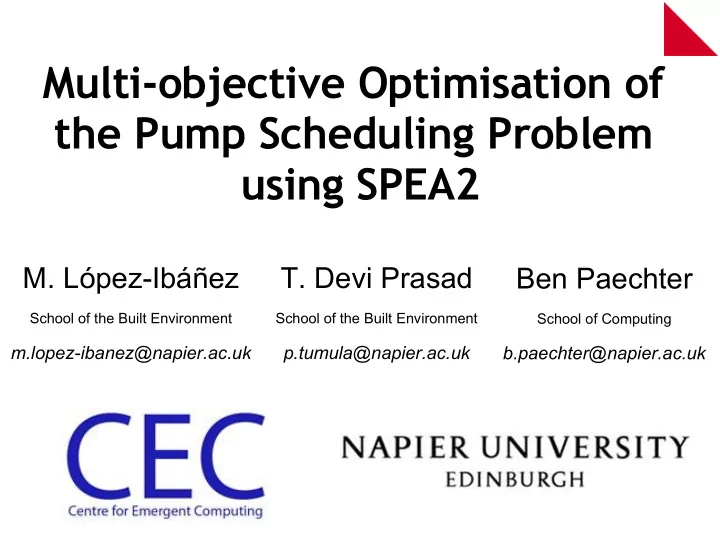

Multi-objective Optimisation of the Pump Scheduling Problem using SPEA2 M. López-Ibáñez T. Devi Prasad Ben Paechter School of the Built Environment School of the Built Environment School of Computing m.lopez-ibanez@napier.ac.uk p.tumula@napier.ac.uk b.paechter@napier.ac.uk
Elements of a (complex) Water Distribution Network • Pipes • Nodes/Junctions • Demand Nodes • Tanks • Reservoirs • Pumps • Other elements: check valves, pressure control valves, …
Operation of Water Distribution Networks Tank Level • Water Demand can be estimated using historical data • We can schedule the operation of pumps for next 24 hours
The Pump Scheduling Problem: (1) Objectives The goal is to minimise the cost of supplying water, while keeping constraints within limits Electrical costs (£/day) Maintenance costs • Pumping to higher elevation • Cannot be exactly measured requires more energy • Pump Switch: from OFF to ON • Different billing periods: peak • Minimisation of Pump Switches and off-peak tariffs. • Demand charge: peak energy consumed • Flow of water (litre/s) affects performance of the pump
The Pump Scheduling Problem: (2) Constraints The goal is to minimise the cost of supplying water, while keeping constraints within limits • Physical constraints (conservation of mass and energy...) • Operational constraints: Periodicity Achieve Water Demand ✗ Negative Pressures ✗ Deficit of Volume (%)
Single Objective versus Multi-Objective Approaches Single objective Multi-objective • Minimise both electrical cost and • Objective function is electrical number of pump switches cost • Number of pump switches is • Output is a Pareto set: another constraint Cheap but • Violation of constraints: wears out pumps penalise objective function / Does not stress reject solution pumps but expensive • One output solution: trade-off between electrical cost and maintenance cost depends on penalties
Solution Methodology Multi-Objective Hydraulic Simulator Optimiser ( EPANET ) ( SPEA2 ) • Handles physical constraints • Binary representation 24 × 1h and minimum and maximum • Recombination tank levels • Uniform • One-point • Models complex networks • Initial Population • It is a black box • Random • Performing a simulation is • From empty solution expensive • From complete solution • From feasible solution • Evaluation time is not constant: Number of Evaluations • No Mutation (fast convergence) • Handling of operational constraints
Constraints Handling Dominance criteria takes into account feasibility [Deb & Jain, 2002] A solution dominates another if: Lower number of pressure violations Lower total volume deficit Normal dominance criteria: the electricity cost and the number of pump switches are not higher and at least one of them is actually lower Feasible solutions (no pressure violations and zero volume deficit) always dominate infeasible ones
Results × • Uniform Crossover average solution of single-objective Hybrid • 6,000 Evaluations GA [Van Zyl et al., 2004] Initial Pop from a Random Initial feasible solution Population
Conclusions • Multi-objective approach is viable • EPANET + SPEA2 + Uniform crossover + Random Initial Population • Equal solution quality (even best-known) within same number of evaluations • Flexibility to trade-off energy costs for maintenance costs • Generates a Pareto set of feasible solutions which can be examined with respect to more subjective operational considerations
Future Work • Alternative representations to the binary string • Different (and larger) network instances • Hybridisation • Other MOEAs (NSGA-II, ...) • Additional objectives: stop time, leakage, water quality, ... EPANET library and network instance available at http://sbe.napier.ac.uk/~manuel/
Recommend
More recommend